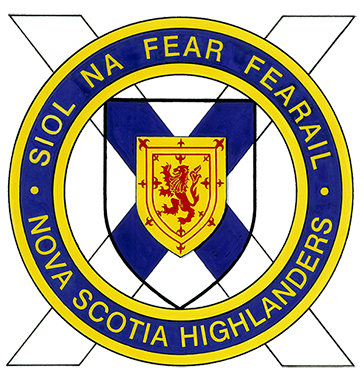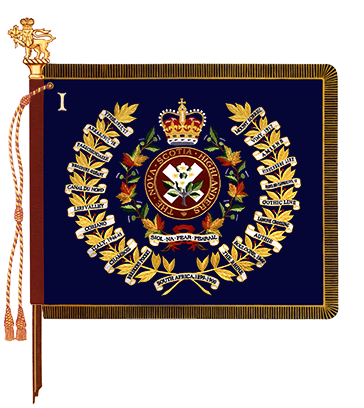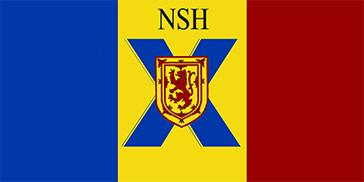The Nova Scotia Highlanders
The official lineage of The Nova Scotia Highlanders infantry regiment.

Badge
Description
A saltire Argent surmounted by the shield of Arms of the Province of Nova Scotia (Argent on a saltire Azure an escutcheon of the Royal Arms of Scotland) encircled by an annulus Azure fimbriated and inscribed above with the motto SIOL NA FEAR FEARAIL and below with the designation NOVA SCOTIA HIGHLANDERS in letters Or.
Symbolism
The saltire refers to St. Andrew, patron saint of Scotland, while the Arms of Nova Scotia refer to the regiment's home in that province.
Motto
SIOL NA FEAR FEARAIL (Breed of manly men)
Marches
"The Sweet Maid of Glendaruel", The Atholl Highlanders", and "The Piobaireachd of Donald Dhu"
Alliance
British Army
The Mercian Regiment
Regimental colour

Camp flag

Battle honours
The War of 1812
Honorary Distinction
The non-emblazonable honorary distinction DEFENCE OF CANADA – 1812-1815 – DÉFENSE DU CANADA
South African War
SOUTH AFRICA, 1899-1900.
The First World War
YPRES, 1915;FESTUBERT, 1915;MOUNT SORREL; SOMME, 1916; Flers-Courcelette; Thiepval; Ancre Heights; ARRAS, 1917; Vimy, 1917; Arleux; Scarpe, 1917; HILL 70; YPRES, 1917; Passchendaele; SOMME, 1918; AMIENS; ARRAS, 1918; Scarpe, 1918; HINDENBURG LINE; Canal du Nord; Cambrai, 1918; PURSUIT TO MONS; FRANCE AND FLANDERS, 1915-18.
The Second World War
NORMANDY LANDING; Authie; CAEN; The Orne; BOURGUÉBUS RIDGE; Faubourg de Vaucelles; Verrières Ridge- Tilly-la-Campagne; FALAISE; The Laison; Chambois; Boulogne, 1944; Calais, 1944; THE SCHELDT; Savojaards Plaat; Breskens Pocket; THE RHINELAND; Waal Flats; The Hochwald; THE RHINE; Zutphen; Leer; NORTH-WEST EUROPE, 1944-1945.
South-West Asia
AFGHANISTAN
Lineage
This Reserve Force regiment originated on 6 April 1871 and incorporates the following regiments and artillery battery.
The Nova Scotia Highlanders originated in Truro, Nova Scotia on 6 April 1871, when the 'Colchester and Hants Provisional Battalion of Infantry' was authorized to be formed.Footnote 1 It was redesignated: '78th Colchester and Hants, or Highlanders Battalion of Infantry' on 1 September 1871;Footnote 2 '78th "Colchester, Hants and Pictou" Battalion of Infantry or "Highlanders"' on 5 September 1879;Footnote 3 '78th Colchester, Hants and Pictou Regiment "Highlanders"' on 8 May 1900;Footnote 4 '78th Pictou Regiment "Highlanders"' on 1 March 1910;Footnote 5 'The Pictou Regiment' on 29 March 1920;Footnote 6 'The Pictou Highlanders' on 2 July 1920;Footnote 7 '2nd (Reserve) Battalion, The Pictou Highlanders' on 7 November 1940;Footnote 8 and 'The Pictou Highlanders (Motor)' on 1 April 1946.Footnote 9 On 12 November 1954, it was amalgamated with 'The North Nova Scotia Highlanders' (see below) and the '189th Light Anti-Aircraft Battery, RCA' (see below) and redesignated the '1st Battalion' of 'The Nova Scotia Highlanders'.Footnote 10
On 9 December 2010 the ‘2nd Battalion, The Nova Scotia Highlanders (Cape Breton)’ was organized as a separate regiment and redesignated ‘The Cape Breton Highlanders’, leaving the 1st Battalion as the single unit within The Nova Scotia Highlanders.Footnote 11
Notes:
The 78th Pictou Regiment "Highlanders" were disbanded for the purpose of reorganization on 2 May 1910 (GO 55/10) and reorganized the next day (GO 138/10). This change was administrative and does not affect the lineage of the regiment.
Upon redesignation as The Pictou Regiment on 29 March 1920 (see above), it was organized as a two battalion regiment with the 1st Battalion (17th Battalion, CEF) on the Non Permanent Active Militia order of battle and the 2nd Battalion (246th Battalion, CEF) on the Reserve order of battle. The reserve unit was disbanded on 14 December 1936 (GO 3/37).
The Pictou Highlanders were disbanded for the purpose of reorganization on 1 February 1921 and reorganized the same day (GO 118/21). This change was administrative and does not affect the lineage of the regiment.
Upon redesignation as The Nova Scotia Highlanders on 12 November 1954 (see above), it was organized as a two battalion regiment.
On 21 June 1955, the 1st Battalion was redesignated '1st Battalion, The Nova Scotia Highlanders (North)' and the 2nd Battalion the '2nd Battalion, The Nova Scotia Highlanders (Cape Breton)' (CAO 110-3, Pt 'B' Supp Issue No. 446/55).
On 12 August 1977, all generic titles in the Canadian Forces, such as 'battalion', were made bilingual (Memorandum, DGBB (Director General Bilingualism and Biculturalism), 1901-1/1211-7-4, 12 Aug 77).
The North Nova Scotia Highlanders originated in Amherst, Nova Scotia on 6 April 1871 when the 'Cumberland Provisional Battalion of Infantry' was authorized to be formed.Footnote 12 It was redesignated: '93rd Cumberland Battalion of Infantry' on 12 June 1885;Footnote 13 '93rd Cumberland Regiment' on 8 May 1900;Footnote 14 'The Cumberland Regiment' on 29 March 1920;Footnote 15 and 'The Cumberland Highlanders' on 15 June 1927.Footnote 16 On 1 December 1936, it was amalgamated with 'The Colchester and Hants Regiment' (less 'C Company') (see below) and 'C Company' of the '6th Machine Gun Battalion, CMGC' (now 'The Princess Louise Fusiliers') and redesignated 'The North Nova Scotia Highlanders (Machine Gun)'.Footnote 17 It was redesignated: '2nd (Reserve) Battalion, The North Nova Scotia Highlanders (Machine Gun)' on 7 November 1940;Footnote 18 '2nd (Reserve) Battalion, The North Nova Scotia Highlanders' on 7 March 1941;Footnote 19 and 'The North Nova Scotia Highlanders' on 1 May 1946.Footnote 20 On 12 November 1954, it was amalgamated with 'The Pictou Highlanders (Motor)' and the '189th Light Anti-Aircraft Battery, RCA', as above.
Notes:
Upon redesignation as The Cumberland Regiment on 29 March 1920 (see above), it was organized as a two battalion regiment with the 1st Battalion (193rd Battalion, CEF) on the Non Permanent Active Militia order of battle and the 2nd Battalion (no CEF designation) on the Reserve order of battle. The reserve unit was disbanded on 14 December 1936 (GO 3/37).
The Cumberland Regiment was disbanded for the purpose of reorganization on 15 October 1920 and reorganized the same day (GO 253/20). This change was administrative and does not affect the lineage of the regiment.
The Cumberland Regiment was disbanded for the purpose of amalgamation on 30 November 1936 and reorganized the next day (GO 180/36). This change was administrative and does not affect the lineage of the regiment.
The perpetuation of the 6th Machine Gun Battalion, CMGC (1919- 1936) was assigned to 'The Princess Louise Fusiliers (Machine Gun)' (GO 76/37).
On 4 May 1951, the regiment mobilized two temporary Active Force companies designated "E" and "F" (CAO 110-2, Pt 'B', Supp Issue No. 245/51 and SD 1 Letter No. 4237, 5 May 1951). "E" Company was reduced to nil strength upon its personnel being incorporated into the '1st Canadian Highland Battalion' for service in Germany with the North Atlantic Treaty Organization (SD 1 Letter No. 4365, 12 November 1951). It was disbanded on 29 July 1953 (CAO 78-2, Pt 'B', Supp Issue No. 352/53). "F" Company was initially used as a reinforcement pool for "E" Company. On 15 May 1952, it was reduced to nil strength, upon its personnel being absorbed by the newly formed '2nd Canadian Highland Battalion' for service in Korea with the United Nations (SD 1 Letter No. 4452, 22 April 1952 and CAO 110-2, Pt 'B', Supp Issue No. 283/52). "F" Company was disbanded on 29 July 1953 (CAO 78-2, Pt 'B', Supp Issue No. 352/53).
The Colchester and Hants Regiment originated in Truro, Nova Scotia on 1 April 1910, when the '70th Colchester and Hants Regiment' was authorized to be formed.Footnote 21 It was redesignated the '76th Colchester and Hants Rifles' on 2 May 1910.Footnote 22 On 15 May 1920, it was amalgamated with the '81st "Hants" Regiment' (see below) and redesignated 'The Colchester and Hants Regiment'.Footnote 23 On 1 December 1936, it was amalgamated, less "C" Company, with 'The Cumberland Highlanders' and 'C Company' of the '6th Machine Gun Battalion, CMGC', as above.
Notes:
Upon redesignation as The Colchester and Hants Regiment on 15 May 1920 (see above), it was organized as a two battalion regiment with the 1st Battalion (25th Battalion, CEF) on the Non Permanent Active Militia order of battle and the 2nd Battalion (106th Battalion, CEF) on the Reserve order of battle. The reserve unit was disbanded on 14 December 1936 (GO 3/37).
The Colchester and Hants Regiment was disbanded for the purpose of reorganization on 15 October 1920 and reorganized the same day (GO 253/20). This change was administrative and does not affect the lineage of the regiment.
The Colchester and Hants Regiment was disbanded for the purpose of amalgamation on 30 November 1936 and reorganized the next day and "C" company was amalgamated with 'The King's Canadian Hussars', now the '88th Field Battery, RCA' on the Supplementary Order of Battle (GO 180/36). This change was administrative and does not affect the lineage of the regiment.
The 81st "Hants" Regiment originated in Windsor, Nova Scotia on 16 February 1914, when an "8 company Regiment of Infantry in Hants County" was authorized to be formed.Footnote 24 It was redesignated: '68th Regiment' on 1 May 1914;Footnote 25 and '81st "Hants" Regiment' on 1 June 1914.Footnote 26 On 15 May 1920, it was amalgamated with the '76th Colchester and Hants Rifles', as above.
The 189th Light Anti-Aircraft Battery, RCA originated in Stellarton, Nova Scotia on 1 April 1946, when the '189th Light Anti-Aircraft Battery, RCA' was authorized to be formed.Footnote 27 On 12 November 1954, it was amalgamated with 'The Pictou Highlanders (Motor)' and 'The North Nova Scotia Highlanders', as above.
Perpetuations
‘1st and 2nd Battalions, County of Sydney Regiment (1812-15)’, ‘1st Battalion, Cumberland Regiment (1812-15)’, ‘Parrsborough Corps (1812-15)’, '17th', '25th', '106th', '193rd' and '246th "Overseas" Battalion(s), CEF'
Headquarters Location
Truro, Nova Scotia
Operational history
South African War
The 193rd Cumberland Battalion of Infantry contributed volunteers for the Canadian Contingents during the South African War.Footnote 28
The First World War
Details of the 76th Colchester and Hants Rifles were placed on active service on 6 August 1914 for local protection duties.Footnote 29
Details of the 78th Pictou Regiment "Highlanders" were placed on active service on 6 August 1914 for local protection duties.Footnote 30
Details of the 93rd Cumberland Regiment were placed on active service on 6 August 1914 for local protection duties.Footnote 31
The 17th Battalion, which was authorized on 19 September 1914 as the '17th Battalion, CEF',Footnote 32 embarked for Great Britain on 29 September 1914.Footnote 33 It was redesignated '17th Reserve Battalion, CEF' on 29 April 1915, to provide reinforcements for the Canadian Corps in the field.Footnote 34 The battalion was disbanded on 21 May 1917.Footnote 35
The 25th Battalion, which was authorized on 7 November 1914 as the '25th Battalion, CEF',Footnote 36 embarked for Great Britain on 20 May 1915.Footnote 37 It disembarked in France on 16 September 1916, where it fought as part of the 5th Infantry Brigade, 2nd Canadian Division in France and Flanders until the end of the war.Footnote 38 The battalion was disbanded on 15 September 1920.Footnote 39
The 106th Battalion, which was authorized on 22 December 1915 as the '106th "Overseas" Battalion', CEF,Footnote 40 embarked for Great Britain on 15 July 1916.Footnote 41 It provided reinforcements for the Canadian Corps in the field until 5 October 1916, when its personnel were absorbed by the '40th "Overseas" Battalion, CEF'.Footnote 42 The battalion was disbanded on 8 December 1917.Footnote 43
The 193rd Battalion, which was authorized on 15 July 1916 as the '193rd "Overseas" Battalion', CEF,Footnote 44 embarked for Great Britain on 12 October 1916.Footnote 45 It provided reinforcements for the Canadian Corps in the field until 20 January 1917, when its personnel were absorbed by the '17th Reserve Battalion, CEF'.Footnote 46 The battalion was disbanded on 18 February 1918.Footnote 47
The 246th Battalion, which was authorized on 1 May 1917 as the '246th "Overseas" Infantry Battalion', CEF,Footnote 48 embarked for Great Britain on 2 June 1917.Footnote 49 On 9 June 1917, its personnel were absorbed by the '17th Reserve Battalion, CEF' to provide reinforcements for the Canadian Corps in the field.Footnote 50 The battalion was disbanded on 11 April 1918.Footnote 51
The Second World War
Details of The Pictou Highlanders were called out on service on 26 August 1939 and then placed on active service on 1 September 1939, under the designation 'The Pictou Highlanders, CASF (Details)', for local protection duties.Footnote 52 The details called out on active service were disbanded on 31 December 1940.Footnote 53
The regiment subsequently mobilized the '1st Battalion, The Pictou Highlanders, CASF' for active service on 1 January 1941.Footnote 54 It served in Newfoundland from March to August 1943 in a home defence role as part of Atlantic Command.Footnote 55 In September 1943, one company was despatched to the Bahamas, where it performed garrison duty until 28 March 1946.Footnote 56 The battalion was disbanded on 30 April 1946.Footnote 57
On 10 September 1942, a sub-component of the regiment, designated 'Special Infantry Company (Pictou Highlanders), CASF', was mobilized for active service.Footnote 58 It served in Bermuda on garrison duty from 12 November 1942 to 1 April 1946.Footnote 59 The company was disbanded on 30 April 1946.Footnote 60
Details of The North Nova Scotia Highlanders were called out on service on 26 August 1939 and then placed on active service on 1 September 1939, under the designation 'The North Nova Scotia Highlanders (Machine Gun), CASF (Details)', for local protection duties.Footnote 61 The details called out on active service were disbanded on 31 December 1940.Footnote 62
The regiment subsequently mobilized 'The North Nova Scotia Highlanders, CASF' for active service on 24 May 1940.Footnote 63 It was redesignated the '1st Battalion, The North Nova Scotia Highlanders, CASF' on 7 November 1940.Footnote 64 It embarked for Great Britain on 18 July 1941.Footnote 65 On D-Day, 6 June 1944, it landed in Normandy, France, as part of the 9th Infantry Brigade, 3rd Canadian Infantry Division, and it continued to fight in North-West Europe until the end of the war.Footnote 66 The overseas battalion was disbanded on 15 January 1946.Footnote 67
On 1 June 1945, the regiment mobilized the '3rd Battalion, The North Nova Scotia Highlanders, CIC, CAOF' for service with the Canadian Army Occupation Force in Germany.Footnote 68 The battalion was disbanded on 1 May 1946.Footnote 69
South-West Asia
From 2002 to 2014, the Nova Scotia Highlanders reinforced various CAF units deployed to Afghanistan.Footnote 70
Page details
- Date modified: